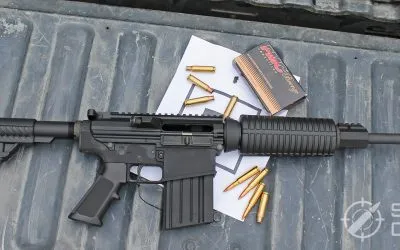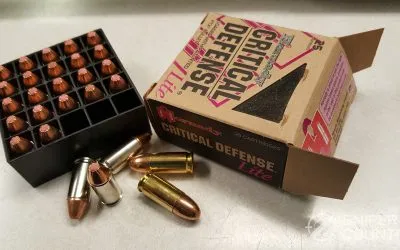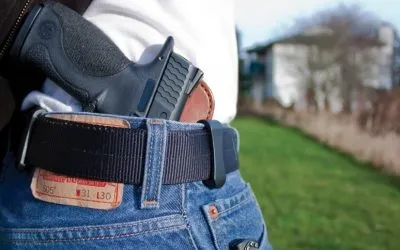The Ruger Bearcat was first released in 1958, let's see how it stands up in 2021.
I like .22 handguns.
Pistols, revolvers, single-shots. They are all fun to shoot, and usually more accurate than they need to be. I either own or have owned, enough .22 handguns to fill a decent-sized duffel bag.
I’ve taken squirrels out of trees and ventilated untold numbers of empty containers over the 40-plus years I’ve shot this caliber of handgun.
From revolvers (single action and double-action) to semi-autos, to even T/C Contender single-shots - I've covered the waterfront, so to speak.
So, when I saw that I could get the new Ruger Bearcat to review, away went my email to my friend at Ruger, and in came the Bearcat.

Ruger Bearcat - the short version
The Bearcat is a small, ornately-engraved single action 6-shot revolver made by Ruger. It's chambered, of course, in .22LR.
Introduced in 1958, discontinued in 1974, and finally reinstated in 1993.
The Bearcat is still one of the hotter-selling wheelguns that bears the Ruger logo.
- Size - with its 4.2" barrel and short overall length, it almost fits in a pocket.
- Fit and finish.
- Transfer bar.
- Accurate for plinking.
- Cylinder engraving.
- Grip panels - very nice rosewood grip panels.
- Ruger's traditional build quality.
- Accuracy was OK for plinking; small-game hunting might be a stretch.
- Trigger exhibited more than a little creep before it broke.
The gun is fine, but I felt it necessary to at least mention some of the areas where Ruger can improve.
The actual build quality was typical Ruger - very nice.
Ruger Bearcat - a History
Ruger introduced the Bearcat revolver in 1958.
Sturm, Ruger & Co started manufacturing guns in 1949. Their first product was the Ruger Standard Mk. I. .22 pistol. Shortly after, revolvers followed. (To read more about Ruger's history with the revolver, read my Ruger Wrangler review).
For almost 70 years Ruger has been manufacturing revolvers. They know what they're doing - the Bearcat is a large part of that story. In production from 1958 to 1974 but then discontinued. Why?

The Ruger Marketing Department Screw-Up
According to Bill Ruger, the Bearcat was to be the first revolver featuring the transfer bar. You know, the bit of metal that goes between the hammer and firing pin after you pull the trigger. This was back in 1973
At the same time, the marketing department forgot to include the Bearcat in Ruger's catalog. No sales came in, of course, and they reported that no one wanted the Bearcat anymore. What did they do? They discontinued the model completely.
Now, many assumed the Bearcat was dropped because it couldn't be fitted with the new transfer bar. This was incorrect. It was a plain screw-up, and the Ruger Bearcat disappeared for almost twenty years...
Fortunately, in 1993, the "new" Ruger Bearcat was released featuring the transfer bar, and the Bearcat was re-born.
BONUS OFFER: Get your free shooting range targets to print at home!
Get your free targets to print at home!
Who Is The Ruger Bearcat For?
If you have a need for a smaller-frame .22 revolver with fixed sights that you could take with you on your trap line runs... or a gun to stick in a bag or pack, the Ruger Bearcat would work.
It's 24 ounces and only 9 inches in overall length.
This size is perfect for allowing you to have a gun on your person whenever you leave the house to do chores. Heck, I’ve owned overalls and coats that had pockets big enough to stick this gun in.
You may want to buy this if you are looking for a plinker. This is great because it's a convenient size. Plus, it has nothing that can be bumped out of alignment (like an adjustable rear sight).
Grab your Bearcat and a box or two of ammo and head to the pasture - no dirt clod is safe from annihilation!
Who Is This Gun Not For?
If you are looking for a precision .22 pistol or revolver that puts all its bullets into one ragged hole at 25 yards... you might want to keep looking.
The Ruger Bearcat isn’t made for hair-splitting accuracy. This is a fun gun, pure and simple.
If precision is what you're looking for, Ruger has many other options to consider.
So Which Ruger. 22 Do I Buy?
This leads to the inevitable comparison…
Ruger .22 single-action revolvers include the Bearcat, Wrangler and Single-Six.
These guns all serve different purposes. You need to know a bit about them before plunking your hard-earned dollars down.
If you haven't read it, you might want to check out my earlier Ruger Wrangler review.
I’ve had experience with Single-Sixes also.
I’ve shot several and owned a Single-Six for a while which accounted for several squirrels high in trees. It was one of the most accurate .22 revolvers I’d ever owned.
Quick reminder. When I say “Single-Six” please understand that there's also the Single-Seven, Single-Nine and Single-Ten. I owned the six-shot version many years ago. For our purposes, I’ll stick to “Single-Six” when talking about that model.
There are some differences between the single-action .22s. Let’s put some of their features side by side…
| Feature | Bearcat | Wrangler | Single-Six |
|---|---|---|---|
| Finish: | Blued | Matte, different colors | Stainless or blued |
| Grip Frame Material: | Alloy steel** | Zinc | Alloy steel** |
| (Cylinder) Frame Material: | Steel | Aluminium | Steel |
| Sights: | Fixed notch/post* | Fixed notch/post | Adjustable rear |
| Capacity: | 6 | 6 | 6, 7, 9 or 10 |
| Trigger: | semi-tuned | basic | tuned |
| Overall Appearance: | Polished, blue steel** | Rougher finish, colors | Polished, blued steel** |
| Relative Cost: | middle | low | high |
*some distributor models feature an adjustable rear sight but stock Bearcats have fixed sights.
**or stainless, depending on model
This little table will help you see the differences between the three models. One thing that needs stating is that all three of these guns are Rugers and will behave accordingly. I don’t think there’s a bad one in the bunch, having either owned or shot all of them.
You just need to decide how you are going to use your Ruger…
- Are you looking to take Mr. Bushytail out of a fork high up in an oak tree? Single-Six.
- Are you wanting a gun to keep by your kitchen door to use when varmints come calling? Single-Six.
- Need a gun to take to the range for an afternoon of paper-punching? Bearcat or Wrangler.
- Want a gun to throw in your boat for a trip on the river? Wrangler.
- How about a .22 that can ride with you in a coat for trips afield? Bearcat.
You get it - no matter what your need, Ruger has a .22 for you. The Bearcat is a very nice choice between the least-expensive Wrangler and the most-expensive Single-Six.
Ruger Bearcat Hands-On
Here is the box the gun came in. Ruger has upped their game by providing a very nice shipping box that can double as a storage container. Here’s what comes in that nice, hard plastic box:

Notice the “one-size-fits-all” box. I have no problem with that, if by using a “generic” box it will save me a buck or two on the gun that goes in it. The lid contains the owner’s manual and other printed material.
The latches are the best part about these boxes - I’ve had several for reviews and they all work very well and are secure. You can padlock the latches shut if desired.
Ease Of Use
Let’s face it - the single-action revolver is, arguably, the easiest handgun out there for ease of use.
To load the gun, pull the hammer to half-cock and flip open the side gate. Stick six .22 LR cartridges, one at a time in each chamber, in the cylinder as you rotate it. You can safely load six because of the transfer bar. Close the side gate, cock the hammer fully back, aim and fire. That’s it.
To unload, open the side gate and rotate the cylinder to where each empty case is lined up with the extraction rod. Push the rod to the rear - this will punch the empties out. Rotate the cylinder to each chamber as you clear them with the rod. It takes longer to describe it than to do it.
Of course, the simplicity involved in loading and unloading for most shooters equates to “slow” ... the single-action revolver is one of the slowest handguns to reload, but for a plinking gun, it doesn’t matter.
Rarely are these guns considered “tactical” ... (but in Laredo, Dodge City or at the O.K. Corral in the late 19th century, they might beg to differ with that assessment!).
Popular Articles
Cleaning
To clean the Bearcat, you need to take it apart. This is easily done…
- Make sure it's empty.
- Open the side gate.
- Press in on the extractor rod release button under the point where the barrel joins the frame.
- Remove the extractor rod by pulling it out.
- Remove the cylinder from the right side of the frame.
That’s it - here are the parts:

Do this to put it back together:
- Place the cylinder back in the frame, with the bolt-stop cutouts to the rear.
- Replace the extractor rod in its hole in the frame while pressing in on the release button. A third arm helps.
- "Wiggle" the cylinder in the frame as you work the rod back into its proper place as it seats at the back of the frame. It will when seated.
- Spin the cylinder (clockwise) to ensure it's seated, as well.
- Close the side gate.
If you don’t get it, the owner’s manual will help, as will numerous YouTube videos. It’s not hard.
Here are a few photos I took of the Bearcat…


Notice the “Bisley”-aspect of the grip. It’s more rounded and at a slightly different angle than the old "plowhandle" grip, which aids in control.

The hammer at half-cock, with that beautiful rosewood grip panel front and center.
The Cylinder

Cylinder Engraving

The engraving truly sets this gun apart from its competitors (and other stablemates that bear the Ruger logo). There is no doubting the caliber, as it is engraved on the cylinder.

The cylinder is of the rimmed variety. Notice the small ring of raised metal at the rear of the cylinder? This design was to protect the shooter in the event of a case rupture, which could release propellant gas. This is not a problem with modern ammo, but it still looks very nice. The chambers are recessed, which is a nice touch.
Sights

Some distributor models offer an adjustable rear sight. However, the Ruger Bearcat base models (stainless and blue) feature only the rear notch.
It works, if your vision will allow you to place the front post in the center of the notch. My vision sometimes struggles to do that.
The above photo also shows the transfer bar, halfway up on the firing pin. The hammer cannot contact the firing pin on its own. It needs the transfer bar in position to “transfer” the energy from the hammer to the firing pin.
This system has been used by Ruger (and others) for a good while. In Ruger’s case, they started using it in 1973. You can send them a pre-1973 Blackhawk revolver and they will install a transfer bar free of charge.

This style of gun is very easy to use, is light and tends to put bullets on paper. Let’s look at a couple of targets…
Range Time With The Ruger Bearcat

I went out today, between rain showers (welcome to spring!), and set a couple of targets up at 15 yards on a portable Caldwell target stand. I decided on 15 yards with this 4-inch-plus-a-fraction barrel instead of 25.
(You might ask, why did Ruger go from the Bearcat’s original 4-inch barrel to one 4.2 inches long - good question! They did it so the guns could be sold in Canada. Barrels there have to be longer than 4 inches. So, when you see specs for, say, a Glock 19 and the barrel is 4.02 inches long, that could be why.).
I shot the left target with CCI Mini-Mag round-nose bullets.
The one on the right with Federal Champion .22 round-nose bullets.
Either of these loads would give you something decent to practice with. Even though not all the rounds are in the orange (or even the yellow), the accuracy is good enough for casual plinking. As I said above, my vision makes the front post a bit fuzzy, so the groups are about the best I can do given the sights on the Ruger Bearcat.
As with all .22 revolvers (and auto-loaders, for that matter), the more types and brands of ammo you try, the better. It’s tough finding ammo these days as we all know, and .22 is included in that. I settled on these two loads because they are fairly standard for performance and availability, at least in normal times.
BONUS OFFER: Get your free shooting range targets to print at home!
Get your free targets to print at home!
Competing Guns
What if you wanted to check out the competition? Are there other .22 single-action revolvers out there? Of course.
The Bearcat’s main competition could bear the Ruger logo. But if you look outside of that brand, you might find a couple of guns that bear checking out.
Heritage Manufacturing
First, there are the Heritage Manufacturing revolvers. I have reviewed more than one of their guns - here’s a link to a couple of them: Heritage Guns and Barkeep
The advantage of the Heritage guns is the price - they tend to be very reasonable, but still decently-built. They are more competition to the Wrangler, which I discussed in my full Wrangler review. But, if you are looking for a short-barreled, small .22 to tote around the ranch, they deserve a look.
Chiappa
Another competitor in the lower reaches of the price range would be the Chiappa revolver. For an MSRP of $185, you get a gun with build quality like the Heritage. The problem with coming up with a .22LR competitor in the Bearcat’s price range is that there aren’t very many.
Its suggested retail price of $639 buys you a decently-made Italian centerfire clone of the 1873 SAA or something similar.
I don’t know of too many guns in that price range that are in .22LR. At least, the couple I named gives you a starting place. Don’t forget to look within the Ruger brand, as well.
Holsters For The Bearcat
I ran across an interesting website while searching for Bearcat holsters. It is Thea.com and they offer a bunch of holsters for the Bearcat. From inexpensive nylon jobs to hand-tooled leather ones. This would be a good place to start your search.
Holsters for either the Chiappa or Heritage guns might fit the Bearcat. Their dimensions of the guns are similar. Not exact, but close. Anyway, a great gun like the Bearcat deserves some nice leather.
For hand-tooled leather holsters that are a bit more upscale, check out Leather Creek Holsters. They have some interesting-looking ones there!
Ruger Bearcat In Conclusion
Looking for a small .22 single-action revolver? Want something a step or two higher on the food chain than the discount-house specials? Take a look at the Bearcat.
This gun fills a niche that has been ignored by most gun makers: a 6-shot, fully-functioning single-action .22LR revolver that will just about fit in a pocket.
Given Ruger’s track record and build quality, the Bearcat should last you for years. It should be there for your great-grandkids to enjoy between their recreational trips to the Moon. It is built to last, and built of quality materials.
The cylinder engraving is icing on the proverbial cake, in my opinion. Add in those pretty rosewood grip panels and the very functional storage box that it comes in... you have a gun that not only will look great but should scratch any rimfire handgun itch you may have.
If you own a Bearcat, let us hear from you below. As always, keep ‘em in the black (orange?) and stay safe!










![9mm Glock Models [Ultimate Guide]](https://snipercountry.com/wp-content/uploads/2018/10/Glock-17-vs-Glock-19-vs-Glock-26-vs-Glock-41-vs-Glock-43-WM-400x250.webp)
![Handgun Caliber Chart [2025 Ultimate Guide]](https://snipercountry.com/wp-content/uploads/2018/10/Handgun-Caliber-Comparison-400x250.webp)
![Rifle Calibers [Ultimate Guide]](https://snipercountry.com/wp-content/uploads/2018/12/Header-1900-400x250.webp)





